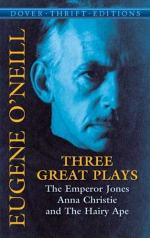|
This section contains 445 words (approx. 2 pages at 400 words per page) |

|
The Hairy Ape Summary & Study Guide Description
The Hairy Ape Summary & Study Guide includes comprehensive information and analysis to help you understand the book. This study guide contains the following sections:
This detailed literature summary also contains Bibliography and a Free Quiz on The Hairy Ape by Eugene O'Neill.
Eugene O'Neill's The Hairy Ape was first produced on March 9, 1922, by the Provincetown Players, a theatrical group that he co-founded. The work was staged in New York City at the company's own Provincetown Theatre. Publication of the play occurred that same year. By this time O'Neill was already an established playwright, having won two Pulitzer Prizes. The Hairy Ape represented something of a departure for him, being an exploration into a more expressionistic style than his previous plays.
The Hairy Ape had been written rather quickly in 1921, and the first production left little time between the final draft and the start of rehearsals. There is some dispute as to who actually directed the first production, with evidence that a triumvirate of Anthony Hopkins, James Light, and O'Neill contributed to the stage direction.
Alexander Woollcot reported in the New York Times that this Provincetown production was "a bitter, brutal, wildly fantastic play of nightmare hue and nightmare distortion." Other critics agreed, finding the play to be a powerful commentary on the human toll exacted from America's bumpy transition from an agrarian to industrial nation. Audiences also identified with O'Neill's characters, who represented, in some form, people from their everyday life.
The Hairy Ape's strong condemnation of the dehumanizing effects of industrialization made it appealing to many labor groups and unions, who seized upon its concepts to further their cause for better working conditions. The play also attracted the attention of the Federal Bureau of Investigation (FBI), which had kept a file on O'Neill. The organization's report on the playwright stated that "The Hairy Ape could easily lend itself to radical propaganda, and it is somewhat surprising that it has not already been used for this purpose."
The Hairy Ape's New York production faced more concrete bureaucratic interference: an attempt was made by the mayor to close the play down for fear that it would provoke labor disputes or riots. Despite the fears of local and federal governments, the play never became a threat in that sense. Rather audiences and critics embraced it as thought-provoking entertainment. Although Woolcott found fault with the play's initial production, he also concluded his review by stating that he found The Hairy Ape to be "a turbulent and tremendous play, so full of blemishes that the merest fledgling among the critics could point out a dozen, yet so vital and interesting and teeming with life that those playgoers who let it escape them will be missing one of the real events of the year." In the years since its debut the play has become one of O'Neill's better-known works and a distinctive exploration of a pivotal period in American society.
Read more from the Study Guide
|
This section contains 445 words (approx. 2 pages at 400 words per page) |

|



